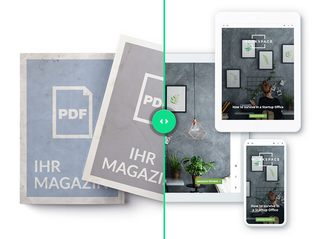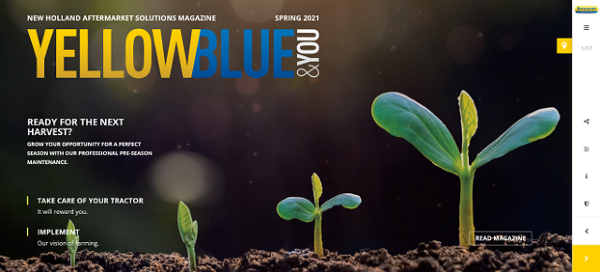
You still publish your newsletter, customer magazine, product brochure and even the whitepaper as PDF file? Probably, a digital version would be better somehow ... but why? We will guide you through seven ultimate reasons why you will never want to use PDFs for your communication again.
Customer magazines, product brochures and white papers - these corporate publications are complex projects in which most businesses invest a lot of time, effort and money. Which marketing department is not satisfied when a pretty high gloss magazine is displayed at the next business event or at an exhibition stand?
And yes, that’s really nice, but you already know it! An emergency solution is almost always chosen for online communication: The print view of the already printed version will be available as a PDF file download on the website.
Note: The PDF format is anything but appropriate for this. Probably most people presage this, but somehow it’s just wonderfully simple. Upload and done. This is not a digital strategy and a huge waste of time. You’ll notice this at latest when you check the amount of downloads.
You need more reasons? There you go: we have compile the six main reasons why you will never want to communicate through PDFs again.
1. PDFs are relics from before cloud-era
Before reading, the potential readers need to download your PDF to their computer. PDFs are heavy because they take up lots of storage space - sometimes an outstanding amount due to images. After reading, the document must be archived or deleted if you do not want it to take up all your hard drive.
For reading a software is required. First the software must be installed on your computer and later it needs to be updated on a regular base. If you wouldn’t do so you would risk the pdf not being displayed correctly or not being displayed at all.
Conclusion: In the age of the cloud, PDF has lost its reason to exist.
2. PDFs are not suitable for smartphones
PDF files were invented to look the same on every device. But that also suggests that they aren’t able to adapt to the variety of end devices – they aren’t responsive.
Everyone who has ever tried to read a PDF file on their smartphone knows that it is not very pleasant. You zoom and scroll all over a huge text and image area and mostly give up after only a few seconds. It doesn't look much better on a tablet and reading is tough even on a desktop PC.
Please remember: 80% of B2B your customers use a mobile device at work. And 80% as well do their products and services researches on tablets during evening hours.
Conclusion: PDF files are totally unsuitable for the mobile age.
PDFs are neither responsive, interactive nor measurable – and therefore totally unsuitable for the mobile, data-driven age.
3. PDF content cannot be found by search engines
All texts in PDF files are anchored in such a way that Google & Co. have no access to it. This means that PDF files are a disaster in terms of search engine optimization.
You write amazing content, give away expert knowledge, provide insights and so much more - but apart from the small group to whom you sent the created content personally, nobody will find it. Potential wasted!
Now imagine your content being read by people you don't even know but who searched for it on Google themselves.
Conclusion: By still using PDF files you hide your content from potential users, readers and customers!
4. PDFs are not interactive
Correct, you can link texts to PDFs. But that’s all. The reader cannot be integrated or activated at all. Forms and call-to-action buttons aren’t existing. Communication via PDFs is a single-sided thing - like a book or a magazine.
That doesn't go along with digital communication, in which customers interact and even want to exchange their ideas with the authors. At the same time, the content creators are loosing all opportunities to get in touch with the readers.
Conclusion: PDF files are static single-use media.
5. PDFs can’t be evaluated
Data analytics? No chance using PDF files. As a creator, you remain completely in the dark about how often your PDF has been read, which devices users are using in general, which article might do well and which is rather not. Knowledge about data usage is essential for your communication! How would you want to optimize your content otherwise? How do you want to find out how many readers open your links and click buttons and eventually perhaps make a purchase?
Conclusion: A PDF file is a black box and you remain completely in the dark about its outcome.
Test Webmag
Creating digital publications is very easy. Thanks to web-based editors such as Webmag, digital publications can now be easily complied using drag & drop and preconfigured design templates. No special knowledge required. Test Webmag for free and create your very own digital customer magazine on a trial basis.
6. PDF files can’t be changed after they have been published
Have you ever tried to edit a PDF after it’s been published? It’s time-consuming, as your original file needs to be redesigned and exported again as a PDF. It's a long and annoying process and the involvement of several people is necessary. Such an effort!
On top of that the old PDF file must be replaced by the new one everywhere you placed it. Readers who have already downloaded the old file will not even notice the changes.
Conclusion: PDFs are inflexible and waste a lot of resources.
7. PDFs are difficult to share on social media
Those who create publications as PDFs are actually hiding them from their interested audience. Not only in terms of search engines, but also when it comes to social media. Or have you ever seen a PDF posted on Facebook? Probably not, because PDFs cannot be shared on Facebook.
Handling PDFs via social media is otherwise rather impractical. In the case of digital magazines, on the other hand, it works smoothly. With every single article. All articles in your magazine can be used, shared and distributed separately in the channels. Simply insert the link and post it to the followers with an automatic preview image and description.
Conclusion: PDFs and social media do not get along.
Forget about your dusty PDFs, welcome to the digital age!
All these reasons make PDFs totally impractical for daily use. Especially as a corporate communication tool they are not up to date. Overall PDFs used as a communication tool pretty much correspond to old dusty books in a library. Heavy, bulky relics from old times. Nowadays there is a much better solution: digital magazines!
Digital means your publications are being published web-based, i.e. simply via a web link which can be opened in any browser without the need to download anything at all. Due to the fact that your publication is built up like a website - search engines can find its content - and potential readers and customers can find the publication on Google, for example. Sharing your publication on social media is no longer a problem.
Digital publications allow you to evaluate all sorts of user data in real time. Businesses can find out how often their magazine has been read, which links have been clicked and much more.
And even more important: digital nowadays also means interactive. Forms or call-to-action buttons can be integrated, just like you know it from your website. Combined with data evaluation, this ends up being a very valuable marketing tool. Your product catalogs suddenly provide you with conversions and white papers not only generate leads per download anymore, but also forward the reader directly to your offers though the content.

Need an example for a digital magazine?
Click here for NEW HOLLAND's digital customer magazine.
Switch into a world of endless new possibilities!
The switch from PDF files to digital web magazine is not only „nice-to-have" for a better look, but it opens up a world of endless new possibilities: Digital First!
You probably wonder: how much effort does it take to create these digital publications? Surprise: It's very simple. Thanks to modular editors such as Webmag, digital publications can be easily compiled by using drag & drop. Preconfigured design templates shorten your time effort significantly and no special knowledge is required.
Publications which have been created with Webmag can be edited at any time with no effort - even afterwards. Similar to a blog, all changes will be visible online in real time and your reader only sees the updated content.
And because everything comes from the cloud, companies have no effort - thanks to software as a service there is no major IT project coming up. Instead, simply start immediately with no risk.
Once you realized what’s possible in the digital world and how easy digitization can be, you won’t ever want to communicate through PDF files again.
You want the ultimate proof?
Send us your PDF and we will create a free digital sample view that shows you exactly what your results will look like.

Container for the dynamic page
(Will be hidden in the published article)


